Have you ever been captivated by the sheer variety of colors and designs that adorn our feline companions? From the mysterious allure of a jet-black cat to the mesmerizing swirls of a tabby, the world of Cat Coat Patterns is a vibrant tapestry woven with genetics, biology, and a touch of evolutionary history.
In this guide, we’ll embark on a journey to unravel the secrets behind feline fur, exploring the diverse cat coat patterns that make each cat uniquely beautiful. Whether you’re a seasoned cat enthusiast or simply curious about your own furry friend’s distinctive look, prepare to be amazed by the kaleidoscope of colors and patterns in the feline world. You might even discover something new about your beloved cat!
Understanding Cat Coat Patterns
Patterns in cat coats are essentially specific arrangements of colors. There are six fundamental cat coat patterns that serve as the foundation for the vast array of feline appearances we see: Solid, Tabby, Bicolor, Tortoiseshell, Tricolor, and Colorpoint. Let’s delve into each of these fascinating patterns.
Solid Coat Patterns
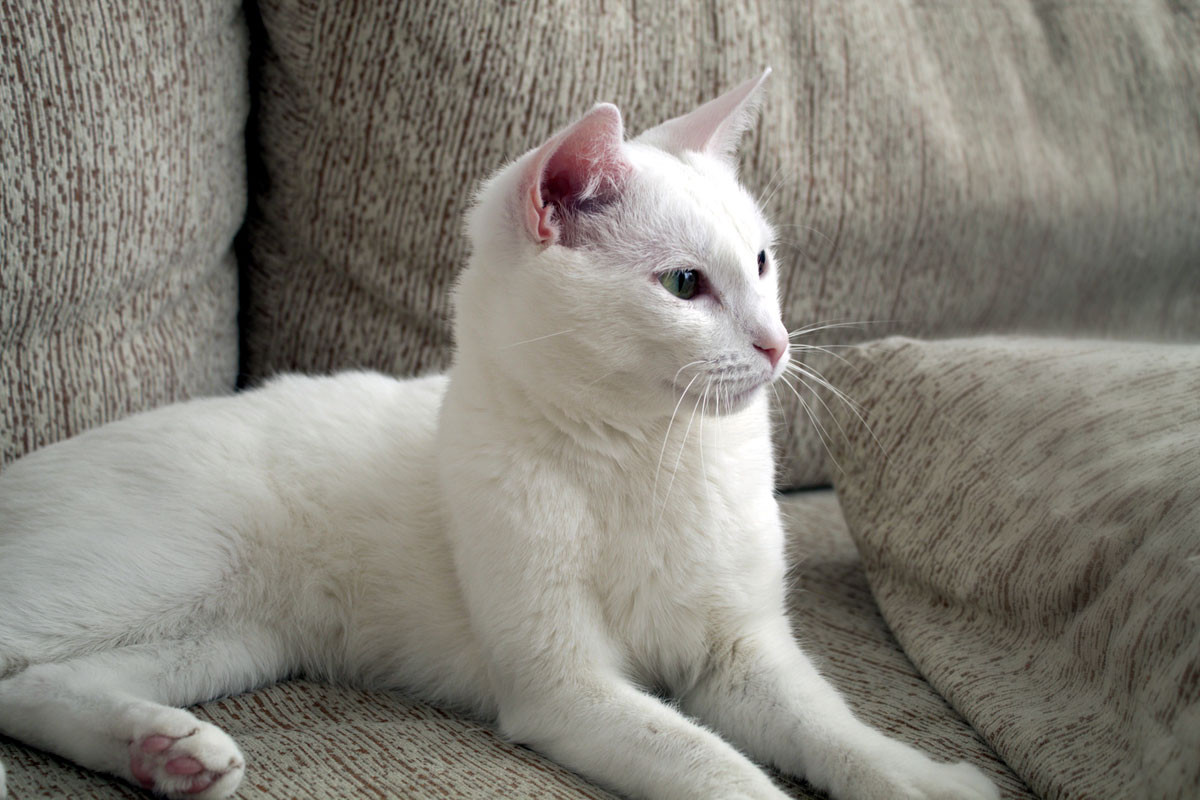 Solid white cat with blue eyes
Solid white cat with blue eyes
The most straightforward cat coat pattern to identify is the solid coat, characterized by a single, uniform color covering the entire body. These cats exude elegance and simplicity.
Interestingly, some solid-colored kittens may exhibit faint traces of a secondary color in their fur, especially when they are very young. These subtle markings are like hidden whispers of their genetic past and typically fade as the kitten matures, giving way to the true solid color. However, if any distinct patches of another color persist, the cat is then classified under a different pattern, such as bicolor or tricolor. In some regions, like the UK, solid-colored cats are often referred to as “self-colored” or simply “selves,” emphasizing their single, unmixed coat color.
Tabby Coat Patterns
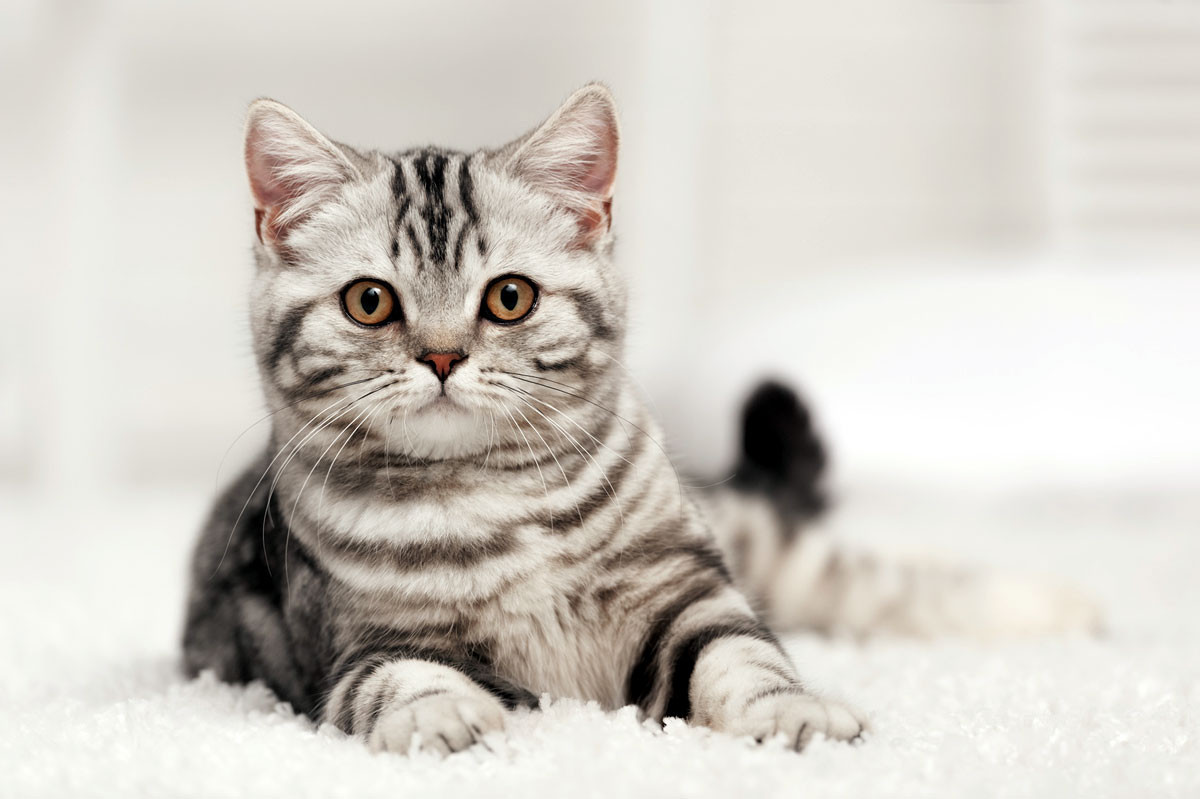 Classic tabby cat with marbled pattern
Classic tabby cat with marbled pattern
The tabby pattern reigns as the most prevalent cat coat pattern, not only in domestic cats but also among their wild feline relatives. This pattern is believed to provide excellent camouflage in natural environments, contributing to its widespread presence. Within the tabby family, there are four distinct variations, each with its own unique charm:
- Striped (Mackerel) Tabby: This is perhaps the most recognizable tabby pattern, featuring narrow, parallel stripes running vertically along the cat’s sides, resembling a mackerel fish skeleton. A distinctive “M” marking is often present on the forehead.
- Blotched (Classic or Marbled) Tabby: Also known as classic tabby, this pattern showcases swirling, broad stripes that create a marbled or oyster-like effect on the cat’s flanks. The “M” on the forehead remains a hallmark of this tabby type.
- Spotted Tabby: As the name suggests, spotted tabbies display spots of varying sizes across their body instead of stripes. These spots can range from small and numerous to large and sparse. Genetically, spotted tabbies are thought to have stripes that have been broken up into spots.
- Ticked (Agouti) Tabby: Unlike the other tabby variations, ticked tabbies lack distinct stripes or spots. Instead, they have agouti hairs, meaning each individual hair shaft is banded with multiple colors. This creates a salt-and-pepper or sandy appearance, often with subtle facial and leg markings. Abyssinians and Somalis are well-known for their ticked tabby coats.
To explore the captivating world of tabby cats in greater detail, you can delve into resources specifically dedicated to Tabby Cats.
Bicolor Coat Patterns
The term “bicolor” simply refers to a cat coat pattern composed of white combined with another color. This secondary color can be a solid hue or exhibit a tabby pattern, adding layers of complexity to the bicolor category. The distribution of white and the other color can vary dramatically, leading to a wide spectrum of bicolor appearances.
Cats with a predominantly white coat are sometimes colloquially termed “Harlequin,” although this isn’t a formally recognized pattern name.
A specific and striking bicolor variation is the “Van” pattern. Van bicolor cats are largely white, with color restricted primarily to patches on the head and tail. This pattern is named after Lake Van in Turkey, the origin of the Turkish Van breed, which is famous for this distinctive look.
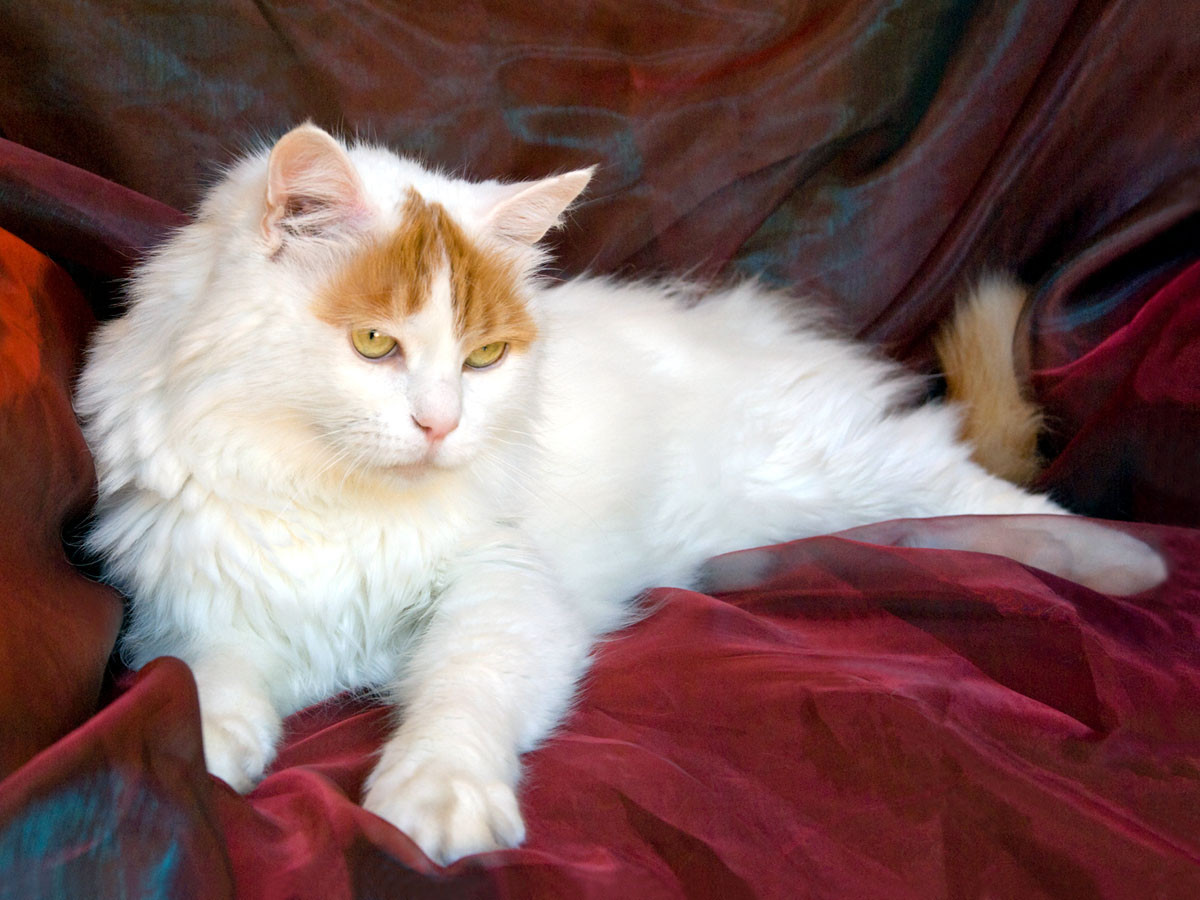 Van bicolor cat with color on head and tail
Van bicolor cat with color on head and tail
Within bicolor patterns, specific terms are often used to describe patches of white depending on their location. A white patch on the chest is known as a “locket,” white markings on the paws are called “mittens,” and small white patches on the abdomen are sometimes referred to as “buttons.”
One particularly popular bicolor combination is the “Tuxedo” cat. This term typically describes a black cat with white markings on the paws, belly, and often the face, creating the impression of a cat dressed in formal attire.
Tricolor and Calico Cat Patterns
The tricolor cat coat pattern introduces a vibrant palette of three colors: white, black, and red (orange), or their diluted versions, cream and blue-gray. The interplay of these colors creates a spectrum of possibilities, with each tricolor cat exhibiting a unique mosaic of hues.
When white is less prominent in a tricolor coat, the other two colors tend to intermingle, resulting in a pattern often called “tortoiseshell and white.” This pattern retains the mottled appearance of a tortoiseshell cat but with the addition of white patches.
As the amount of white in the coat increases, the patches of red (orange) and black become more clearly defined and separated by white areas. This leads to the quintessential “calico” pattern. Calico cats are celebrated for their distinct patches of white, black, and orange, creating a striking and visually appealing cat coat pattern.
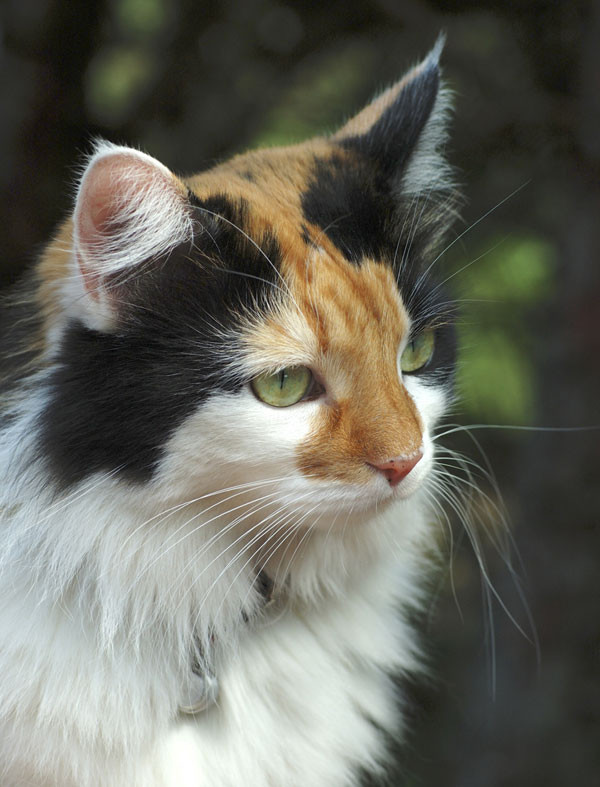 Calico cat with distinct patches of color
Calico cat with distinct patches of color
Dive deeper into the captivating world of calico cats and the fascinating genetics behind their tri-color coats in dedicated resources like a Calico Cats Guide.
Tortoiseshell Pattern
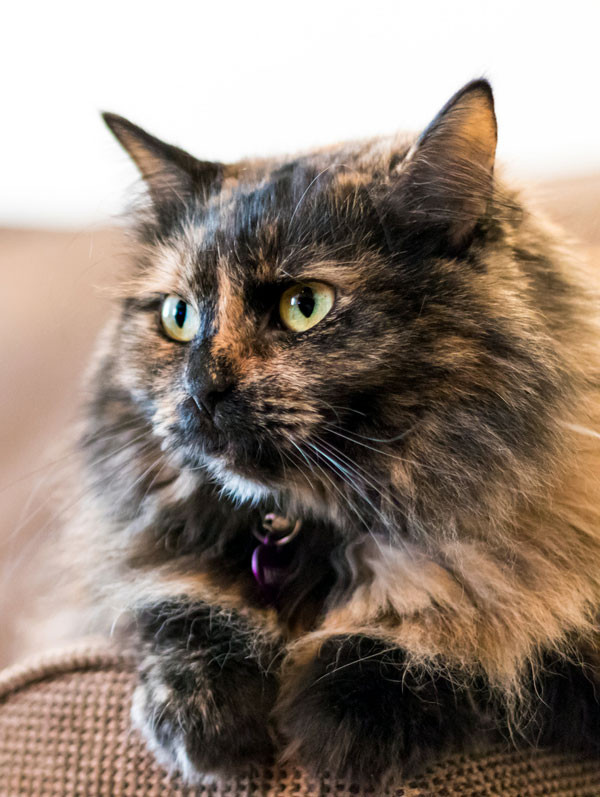 Tortoiseshell cat with mottled orange and black fur
Tortoiseshell cat with mottled orange and black fur
The tortoiseshell pattern, often affectionately shortened to “tortie,” is a captivating blend of orange and black (or their diluted counterparts, cream and blue-gray) intermixed throughout the coat. This pattern creates a mottled or patchwork appearance, reminiscent of the shell of a tortoise.
A fascinating genetic quirk associated with tortoiseshell cats is that they are overwhelmingly female. The genes responsible for orange and black coat colors are located on the X chromosome. Females, with two X chromosomes (XX), can inherit both color genes, leading to the tortoiseshell mix. Males, with only one X chromosome (XY), typically inherit either the orange or black gene, but rarely both. Tortoiseshell males are rare genetic anomalies, usually resulting from a chromosomal abnormality (XXY), and are almost always sterile.
Tortoiseshell cats can sometimes exhibit an underlying tabby pattern within their colored patches. This combination of tortoiseshell and tabby is often referred to as “torbie,” adding another layer of complexity to feline coat patterns.
Colorpoint Patterns
In the colorpoint pattern, the cat’s body is predominantly light-colored, while the “points”—the face, paws, and tail—display a darker, contrasting color. This pattern is most famously associated with Siamese cats but is found in various breeds.
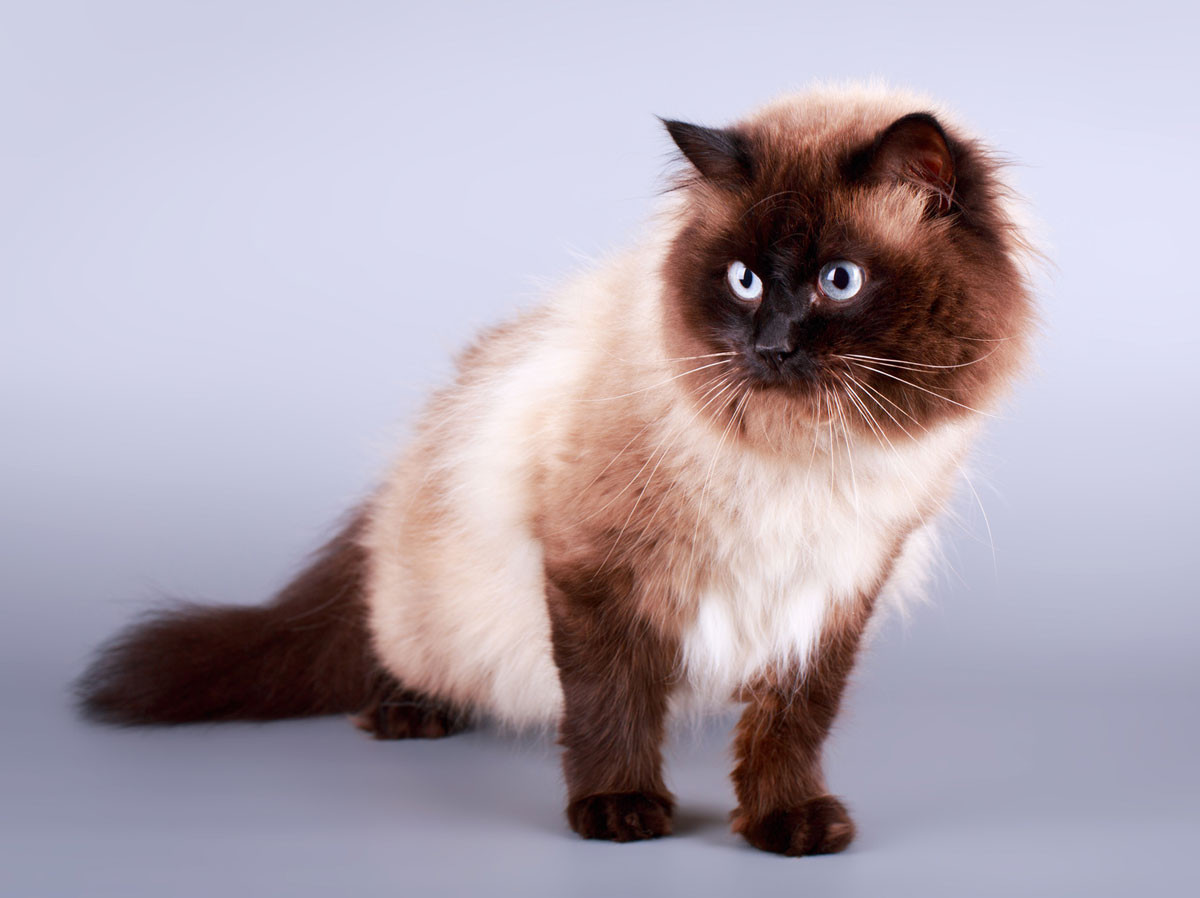 Seal point colorpoint cat with dark face, paws, and tail
Seal point colorpoint cat with dark face, paws, and tail
The color of the points can vary widely, encompassing shades like dark brown (referred to as “seal point”), red (known as “flame point”), blue-gray, and lilac. The contrast between the body color and the points is most pronounced in younger cats and may become less distinct as the cat ages.
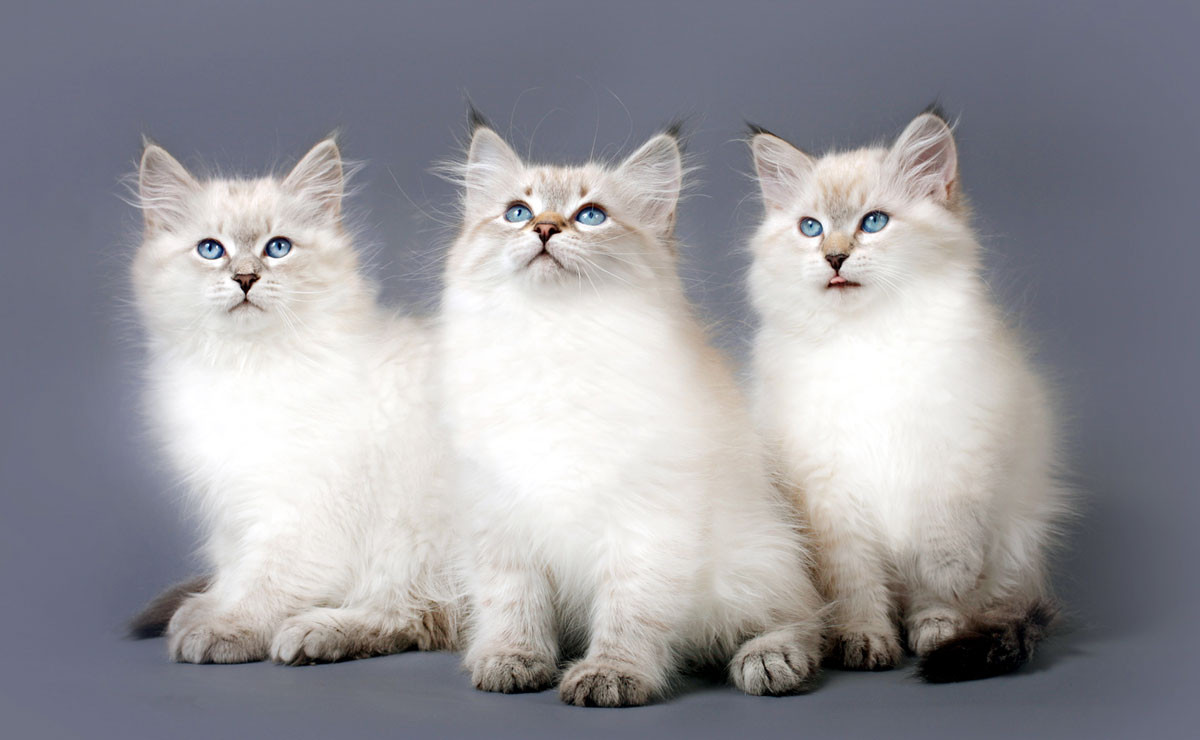 Colorpoint kittens with lighter body and darker points
Colorpoint kittens with lighter body and darker points
Interestingly, colorpoint patterns can also incorporate tricolor or tabby patterns within the points themselves. Tabby points are sometimes called “lynx points,” adding further diversity to the colorpoint spectrum.
Exploring Cat Coat Colors
Having explored the fundamental cat coat patterns, let’s now turn our attention to the diverse palette of colors that bring these patterns to life. Remember that most of these colors can manifest as solid coats or be incorporated into tabby, bicolor, or other patterns. The possibilities are truly a rainbow of feline hues! 🌈
White Cats
White is unique among cat coat colors as it is always a solid color, devoid of any underlying tabby markings. However, the genetics of white coats are complex, with several genetic pathways leading to a white phenotype. Some genes create all-over solid white cats, while others contribute to bicolor or tricolor patterns where white is combined with other colors.
It’s worth noting that a specific genetic variant responsible for solid white coats is sometimes linked to deafness. However, it’s crucial to understand that not all white cats are deaf, and conversely, not all deaf cats are white. The association is a statistical tendency, not a definitive rule.
Black Cats
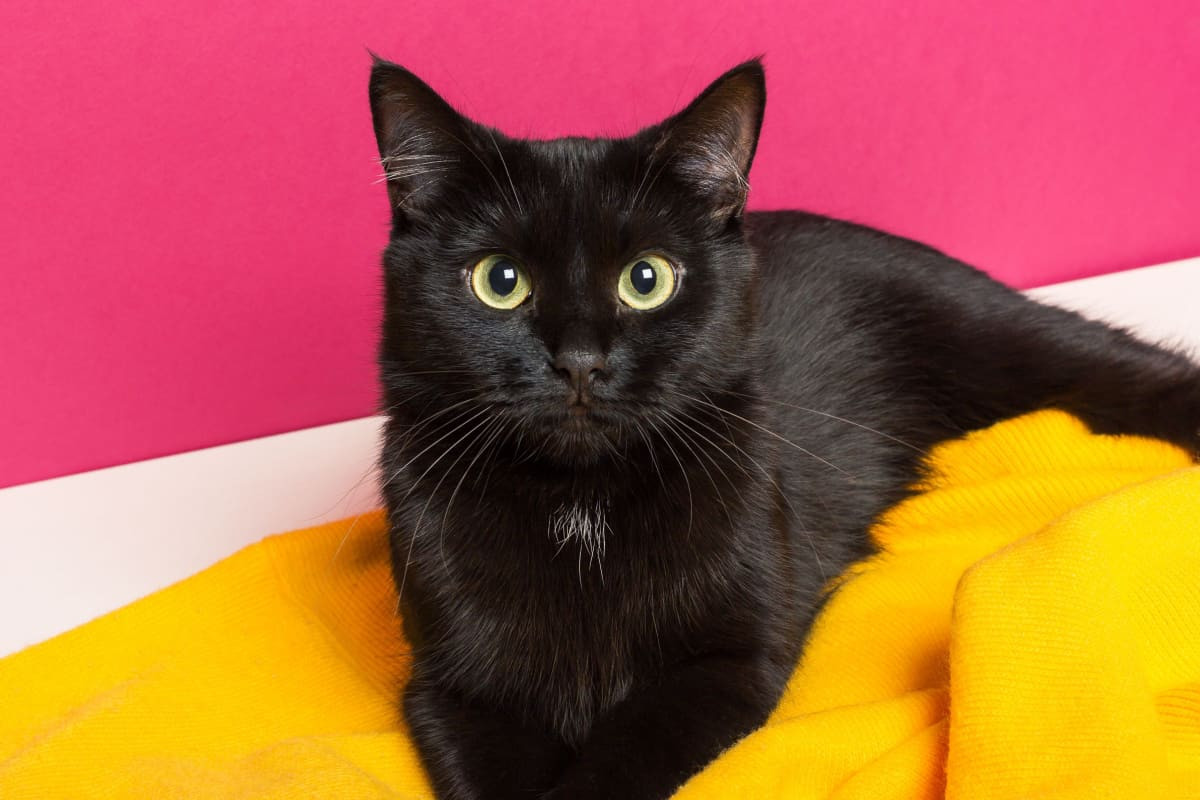 Elegant black cat lounging on a yellow blanket
Elegant black cat lounging on a yellow blanket
Solid black cats exude an air of mystery and sophistication. While a true, jet-black coat is often prized in cat breeding, many black cats carry underlying tabby markings that may become subtly visible, especially in certain lighting conditions. Exposure to prolonged sunshine can sometimes cause a black coat to develop a rusty or brownish tinge, a testament to the pigment’s sensitivity to UV radiation.
In the colorpoint pattern, the black gene manifests as a dark brown hue, referred to as “seal point.” This highlights how the same color gene can express itself differently depending on the overall cat coat pattern.
Red Cats
“Red” is the formal genetic term for the cat coat color more commonly known as orange, ginger, or marmalade. The gene responsible for red color is sex-linked and resides on the X chromosome, similar to the genes for black color. This sex linkage explains why red cats are predominantly male. Female cats need to inherit the red gene on both of their X chromosomes to be red, while males only need to inherit it on their single X chromosome.
Red color is strongly associated with the tabby pattern. Achieving a true solid red coat is genetically challenging, and most “red” cats will exhibit some degree of tabby markings, even if faint. In the colorpoint pattern, red translates to “flame point,” further demonstrating the interplay between color and pattern.
Blue Cats
The “blue” cat coat color is not a true blue but rather a diluted version of black. It presents as a soft, deep bluish-gray, often described as slate gray. Certain cat breeds, such as Russian Blues and British Shorthairs, are particularly associated with this elegant color, but blue coats can appear in many breeds and mixed-breed cats.
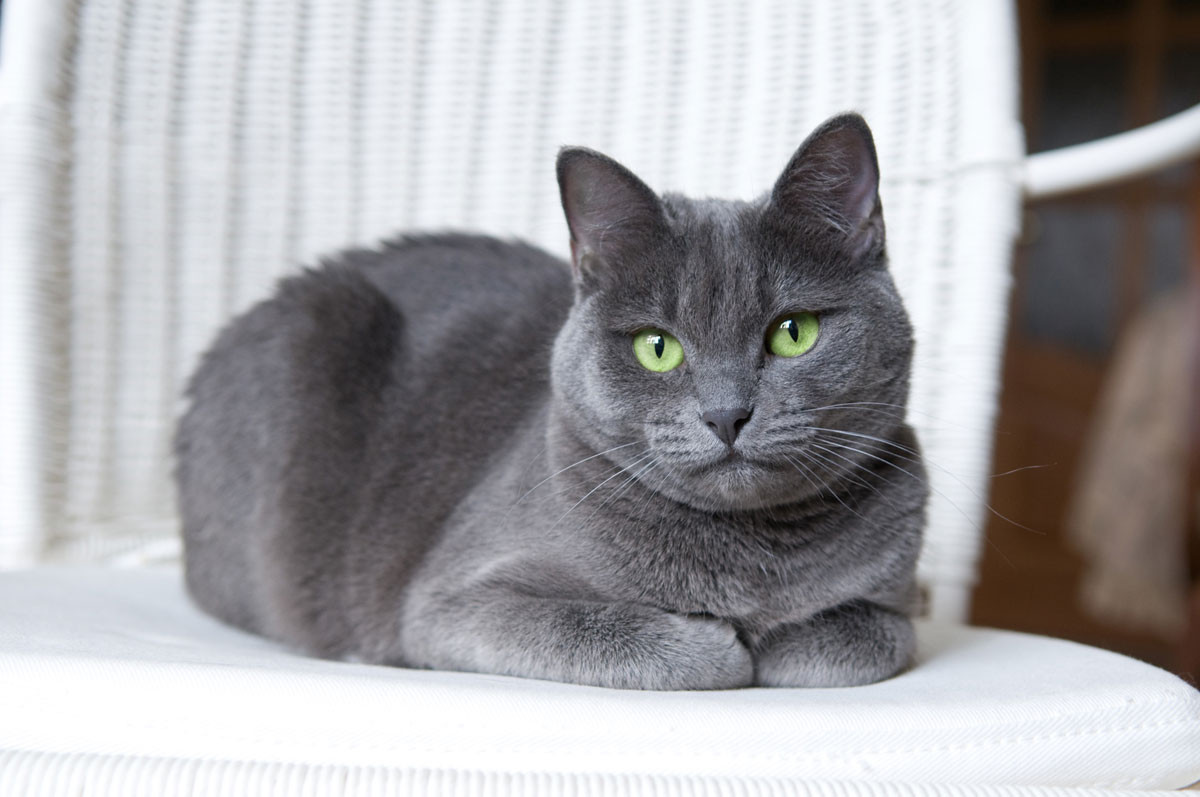 Blue-gray cat with striking green eyes
Blue-gray cat with striking green eyes
Cream Cats
Cream is the diluted version of red (orange), just as blue is the diluted version of black. Cream cat coat color is a pale, soft, and warm off-white or pale beige. In combination with blue, cream plays a crucial role in creating dilute calico and dilute tortoiseshell patterns, expanding the spectrum of feline coat possibilities.
Brown Cats
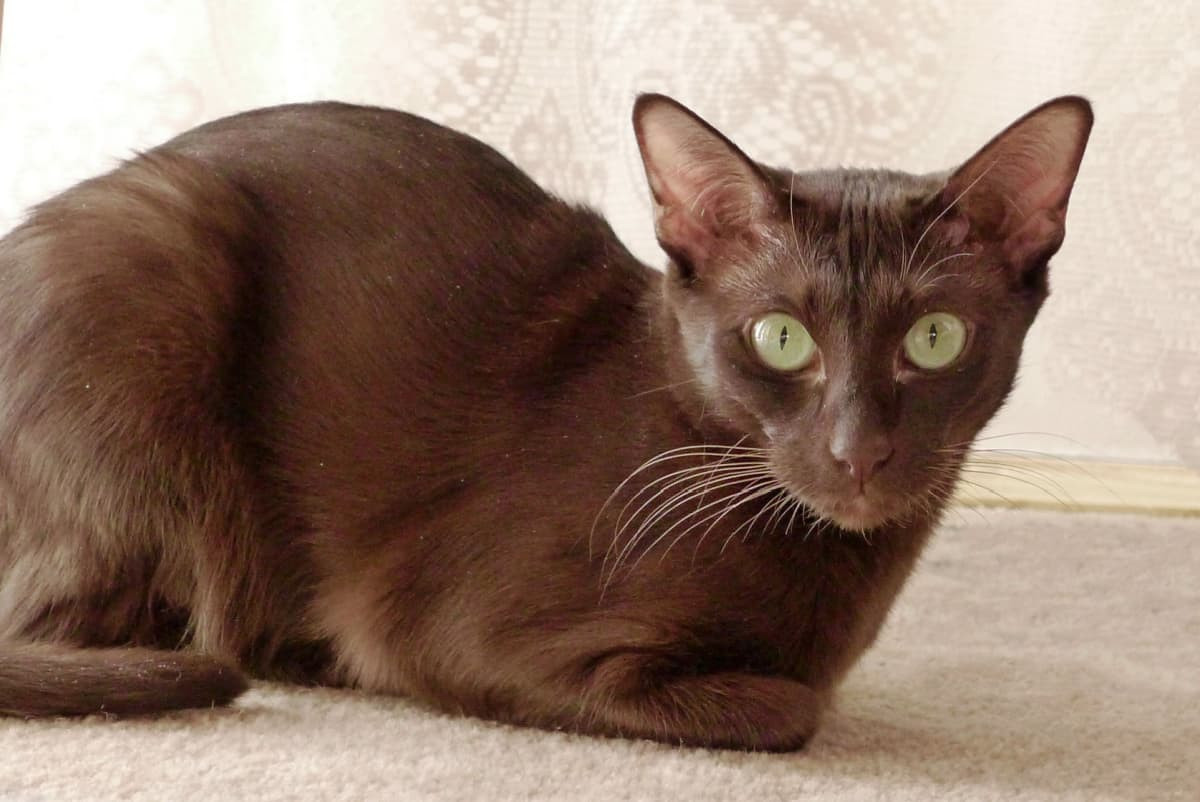 Havana Brown cat with rich brown fur
Havana Brown cat with rich brown fur
Solid brown cats are relatively uncommon compared to other solid cat coat colors. The Havana Brown breed is particularly renowned for its rich, chocolate-brown coat. In some breeds, brown variations may also be called “chocolate,” further emphasizing the warm, deep brown hue.
Lilac or Lavender Cats
“Lilac” and “Lavender” are interchangeable terms used to describe a delicate, light gray-brown shade with subtle pinkish undertones. This color is often considered a diluted version of chocolate brown. Different cat associations and breed clubs may favor one term over the other, but both refer to the same elegant cat coat color. In the colorpoint pattern, lilac points are referred to as “frost points.”
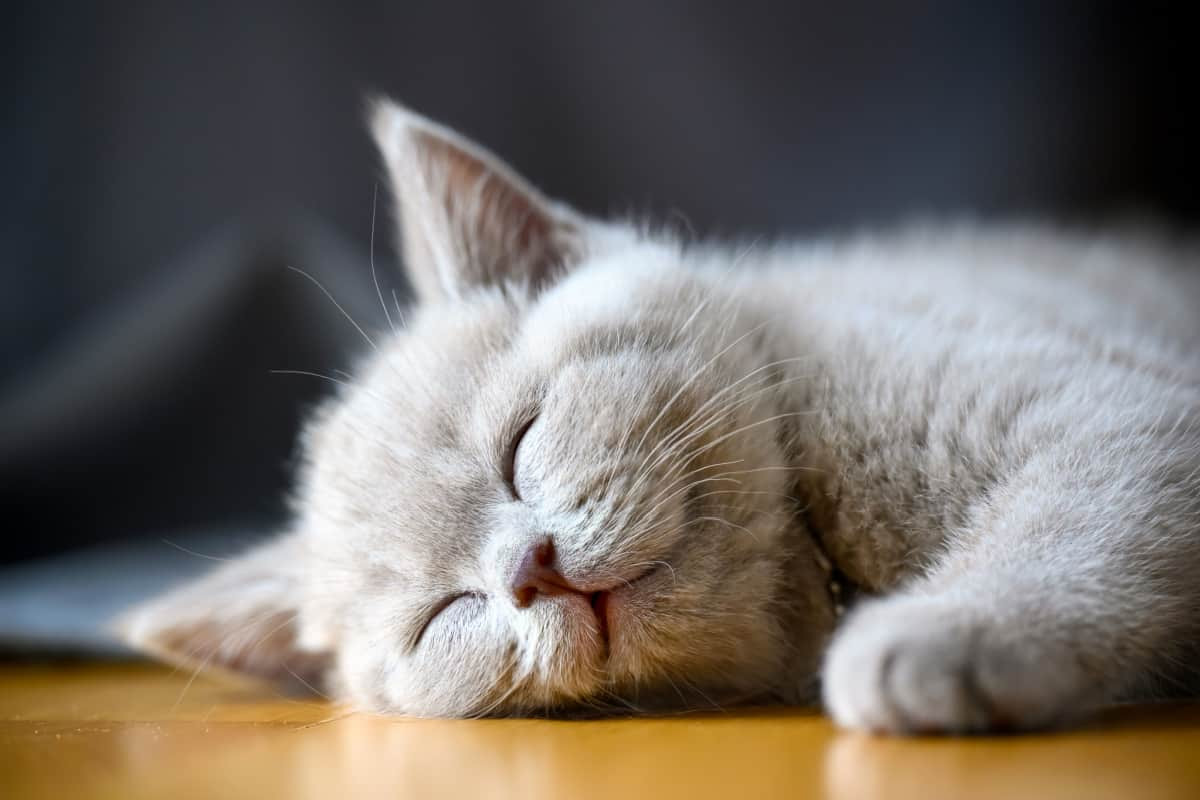 Lilac or lavender cat sleeping peacefully
Lilac or lavender cat sleeping peacefully
Cinnamon Cats
Cinnamon is a variety of solid light brown with distinct reddish undertones, reminiscent of the spice it’s named after. Cinnamon cat coat color brings a warm, spicy, and unique flair to the feline palette.
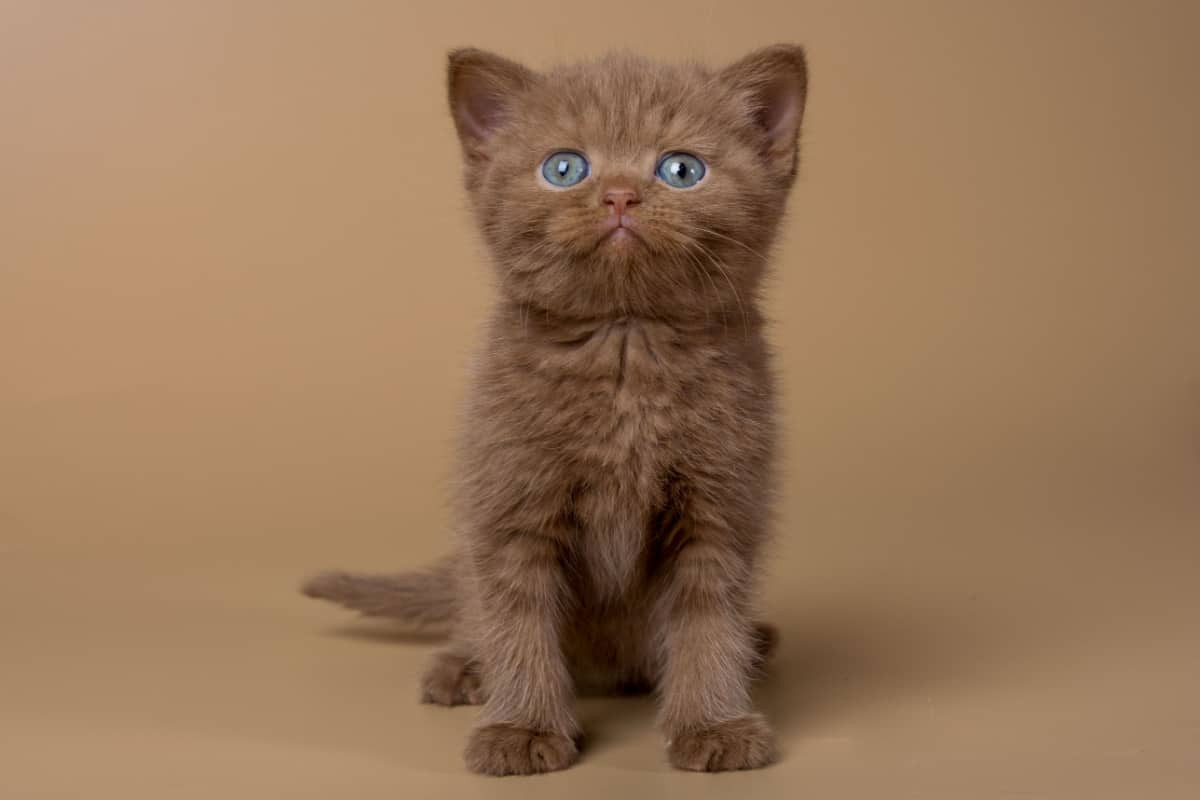 Cinnamon colored cat with reddish-brown fur
Cinnamon colored cat with reddish-brown fur
Fawn Cats
Fawn is the diluted version of cinnamon, just as cream is diluted red and blue is diluted black. Fawn cat coat color is a very pale, warm beige or light tan, often described as a delicate and soft hue. Fawn cats possess a gentle and captivating beauty.
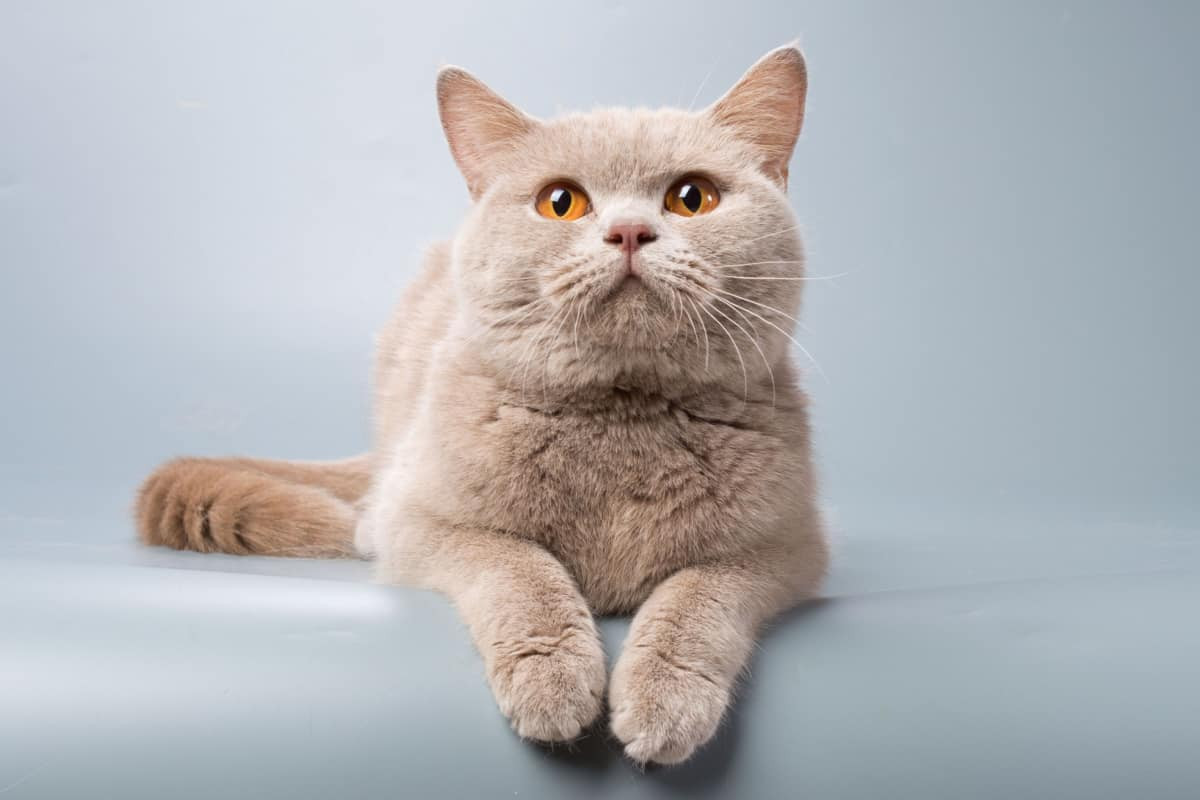 Fawn colored cat with light beige fur
Fawn colored cat with light beige fur
Special Effects in Cat Coat Color
Beyond solid colors and distinct patterns, some cats exhibit spectacular “special effects” in their coats. These effects are achieved by variations in pigment distribution along the length of individual hair shafts, resulting in striking visual textures. These special effects typically involve a change from a lighter base color (usually white or cream) to a darker color at the hair tip. There are three primary types of these tipped effects:
Tipped Cat Coat Special Effects
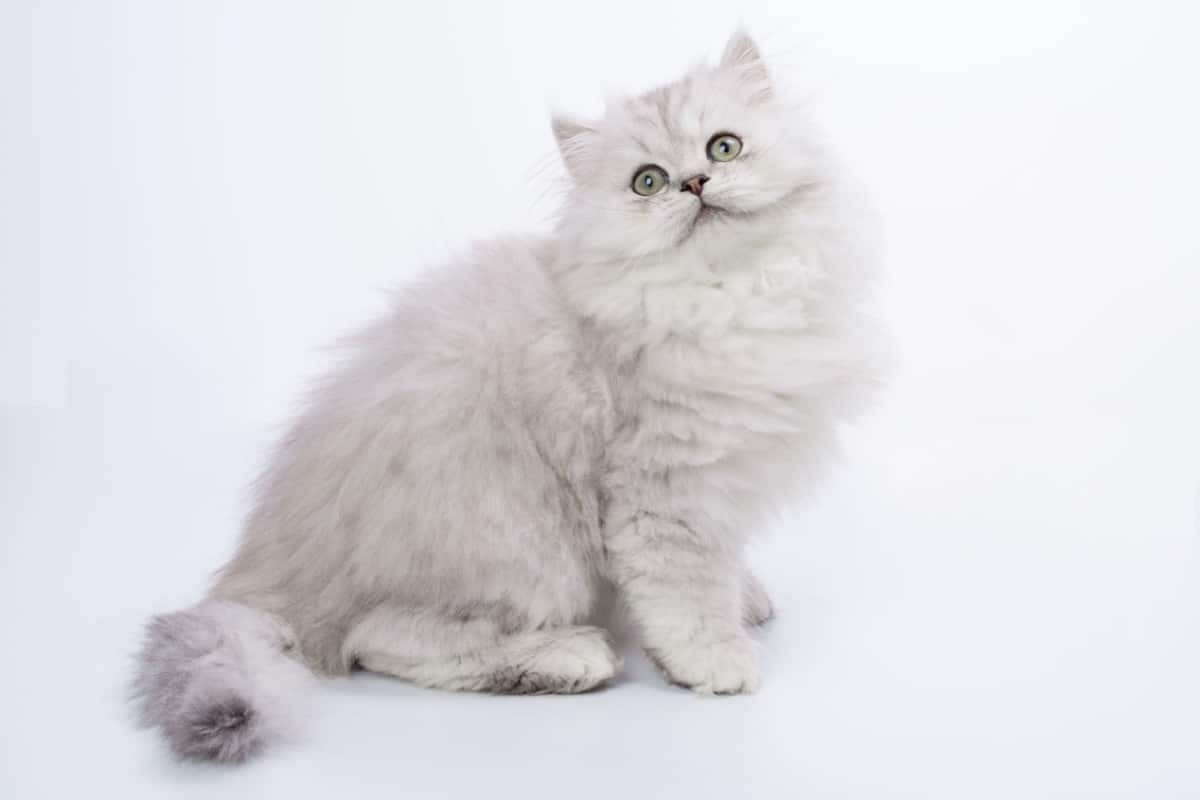 Chinchilla cat with silver-tipped fur
Chinchilla cat with silver-tipped fur
In tipped coats, only the very tips of the hairs are pigmented with a darker color, while the majority of the hair shaft remains light. This creates the exquisite “Chinchilla” effect, where the cat appears almost entirely white or cream, but with an overall shimmering, silvery or golden overlay depending on the tip color. This effect is sometimes also referred to as “Shell.”
Shaded Cat Coat Special Effects
Shaded coats represent an intermediate level of tipping. In shaded coats, roughly half of the hair shaft is light at the base and half is dark at the tip. This creates a richer, more pronounced contrast between light and dark than tipped coats, resulting in a captivating play of color.
Smoked Cat Coat Special Effects
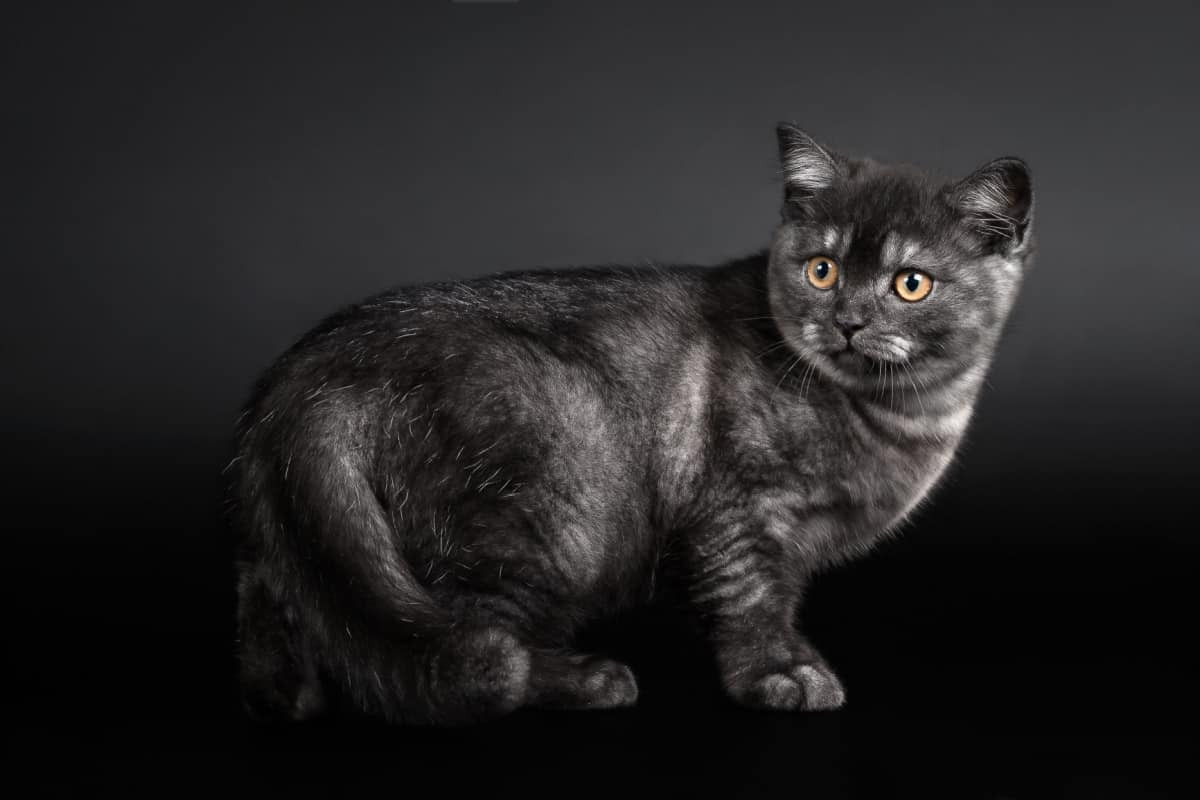 Black smoke kitten with light undercoat visible
Black smoke kitten with light undercoat visible
Smoked coats are characterized by hairs that are mostly dark in color, with only a narrow band of light color at the very base, close to the skin. The light undercoat is largely hidden when the cat is still, but it becomes visible as the cat moves, creating a “smoky” or shadowy effect. Smoked coats add an air of mystery and depth to a cat’s appearance.
Common and Rare Cat Colors & Patterns
With such a vast array of cat coat colors and cat coat patterns, it’s natural to wonder about the prevalence of each. While a definitive global census of cat colors and patterns doesn’t exist, we can glean insights from available data, such as shelter statistics.
Technically, all cat colors are variations of black, red, or white as base pigments. The incredible diversity arises from genetic modifications, dilutions, and pattern arrangements of these fundamental colors. Pinpointing the absolute “most common” cat coat pattern is challenging due to the sheer number of combinations.
However, data from organizations like the RSPCA (Royal Society for the Prevention of Cruelty to Animals) in Britain offers valuable clues. According to their shelter intake data, black and white bicolor cats, closely followed by solid black cats, are among the most frequently encountered. Tabby cats rank third in terms of shelter populations, although still very common. This suggests that black and black-and-white cats are indeed quite prevalent overall.
On the other end of the spectrum, certain cat coat colors and effects are considered rarer. Smoked, shaded, and tipped effects, while visually striking, are less frequently observed in the general cat population compared to solid or tabby patterns. Chocolate and cinnamon solid colors are also less common, often associated with specific pedigree breeds like Havana Browns.
Breeders sometimes actively work to create and preserve unique and less common cat coat patterns and colors, contributing to the ongoing diversity and beauty of the feline world.
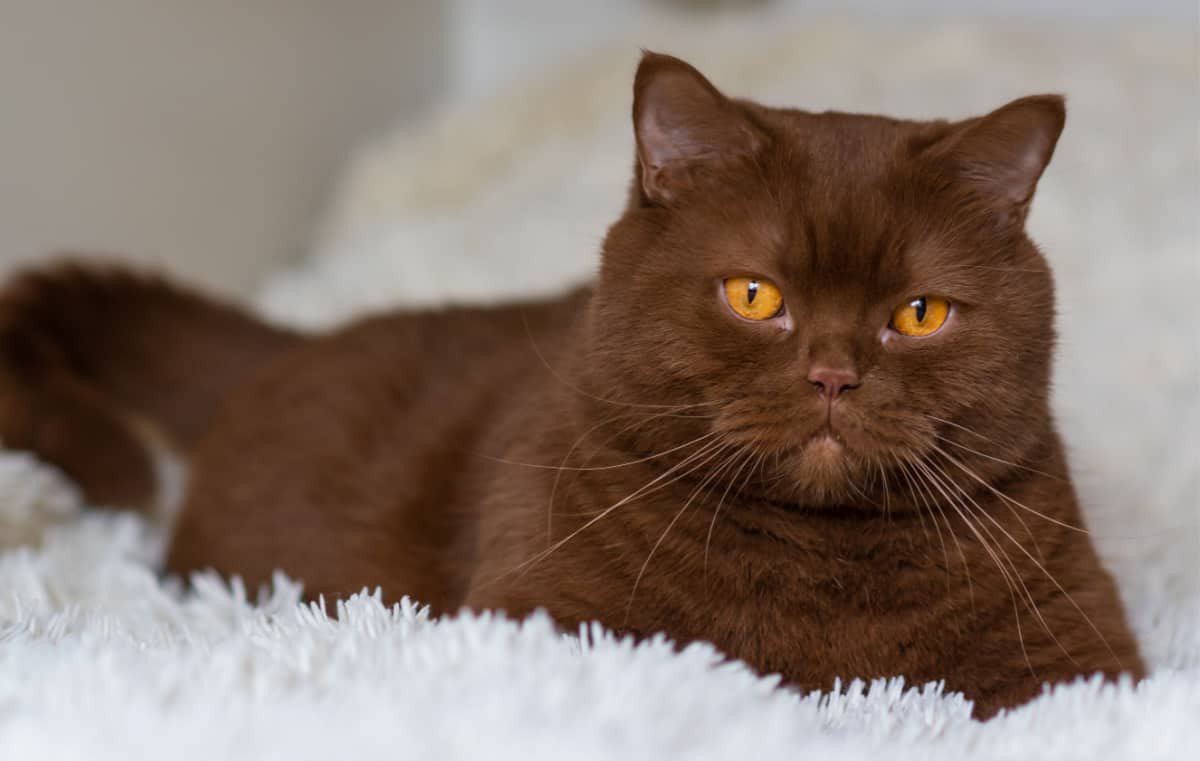 Brown cat comfortably resting indoors
Brown cat comfortably resting indoors
Cat Coat Length: An Additional Dimension
The length of a cat’s fur, along with its texture, significantly influences how colors and patterns are perceived. Some coat effects and patterns may be more pronounced or even exclusively found in long-haired cats.
Cat fur length ranges dramatically, from virtually hairless in some breeds to luxurious, flowing coats requiring extensive grooming. However, for general classification, cat fur length is broadly categorized as either short-hair or long-hair.
An interesting quick indicator to differentiate between short and long-haired cats is to examine the fur between their toes. Long-haired cats often exhibit fur protruding visibly from between their toes, while short-haired cats tend to have a more uniform, less protrusive fur length in this area.
Breeds like Persians, Ragdolls, and Maine Coons are classic examples of long-haired cats. Long hair is generally defined as fur exceeding 1.5 inches in length and can reach up to 5 inches or even longer in some breeds. Long-haired cats require regular grooming to prevent matting and tangles.
Domestic Shorthair cats, the most common type, have fur strands shorter than 1.5 inches. They are relatively low-maintenance in terms of grooming, as their shorter fur allows them to manage their coat effectively themselves. Breeds like Manx, Savannah, and Burmese fall into the short-haired category.
What About Bald Cats?
“Bald cats,” such as Sphynx, Bambino, and Peterbald breeds, are fascinating variations. While termed “bald,” they are technically a variation of short-haired cats, possessing a very fine, downy coat that is barely visible.
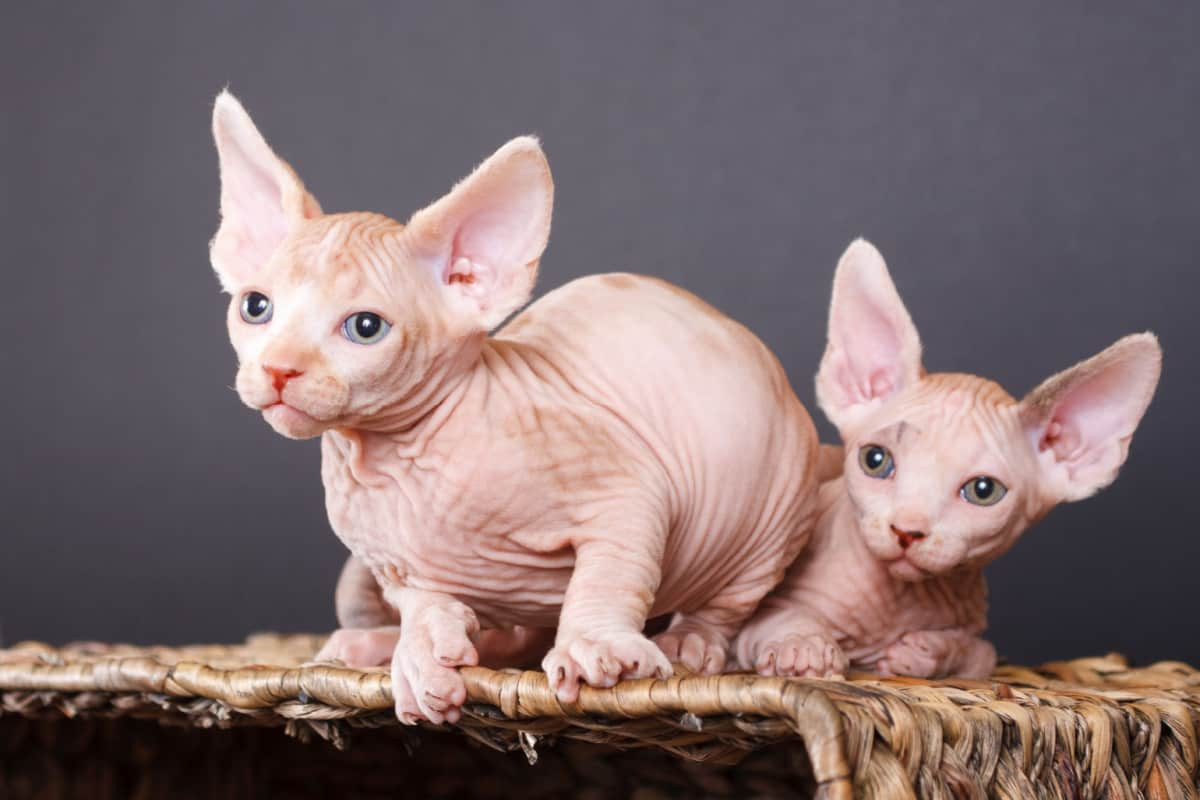 Sphynx kittens huddled in a basket
Sphynx kittens huddled in a basket
The lack of a dense fur coat accentuates the skin’s wrinkles and contours, giving these breeds a unique and distinctive appearance. Despite their minimal fur, bald cats exhibit the same range of cat coat colors and cat coat patterns as their furred counterparts. They can be black, white, blue, calico, bicolor, tabby, or colorpoint. However, the underlying pink skin tone subtly mixes with the coat color, creating a unique visual effect—for example, white Sphynx cats often appear pinkish due to their skin tone showing through.
Bald cats require specific care. They need more frequent bathing than furred cats to remove skin oils and are more vulnerable to temperature extremes. They feel cold easily in winter and are susceptible to sunburn in summer due to the lack of fur protection.
And Some Cats Actually Have Curls!
Curly-coated cats are another captivating deviation from the standard feline fur. Breeds like Selkirk Rex, Devon Rex, Cornish Rex, and LaPerm possess naturally wavy or curly fur due to a genetic mutation affecting hair follicle development. These cats are missing one of the three gene types that typically form a straight hair shaft, resulting in a curled or crimped hair texture.
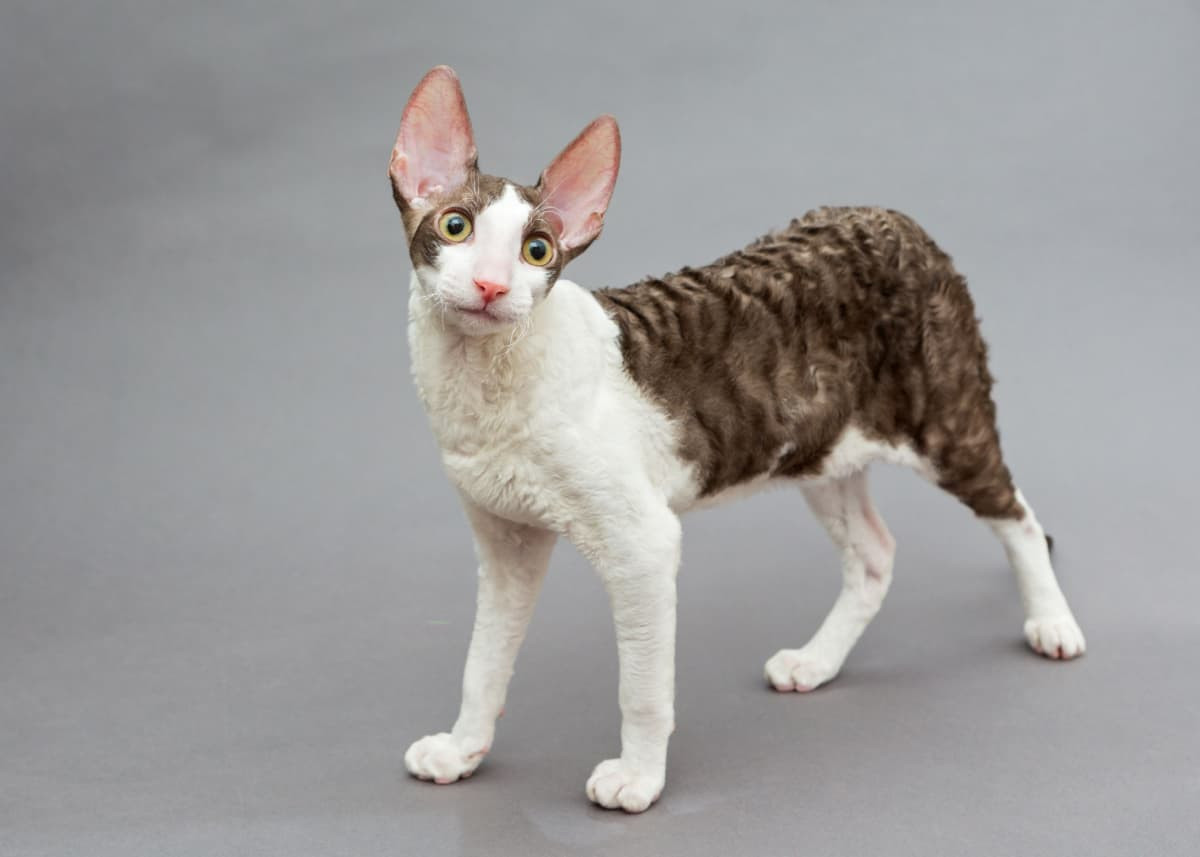 Cornish Rex cat with curly coat
Cornish Rex cat with curly coat
Despite their seemingly unruly fur, curly-coated cats often shed less than straight-haired breeds. Interestingly, their whiskers are often curly as well. Curly cats can exhibit all cat coat patterns and colors, including colorpoint. The specific curl type and allowed appearance vary between curly-coated breeds.
Explore the World of Cat Colors & Patterns Further
The realm of cat coat colors and cat coat patterns is a testament to the incredible diversity and beauty within the feline species. From the bold stripes of tabbies to the mesmerizing swirls of tortoiseshells, and the unique textures of Rex breeds, each cat is a living work of art.
So, the next time you encounter a cat, take a moment to appreciate the intricate details of its fur. Each pattern and color tells a story, woven from genetics and shaped by evolution.
To continue your exploration of feline wonders, you might enjoy these related resources:
- Black Cat Facts And Myths
- Tabby Cats
Share this guide with fellow cat lovers and save the image below for future reference!
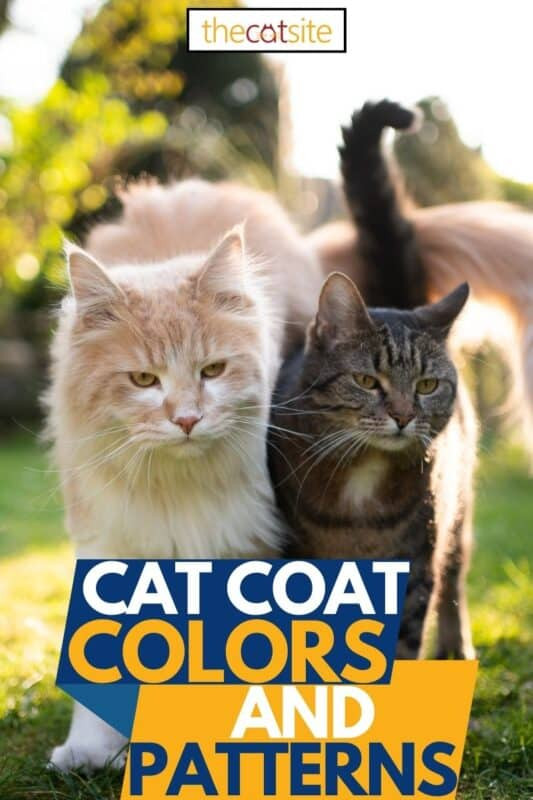 Cat Coat Colors And Patterns pin image
Cat Coat Colors And Patterns pin image
Note: We may receive commissions on purchases made through links on this page.
